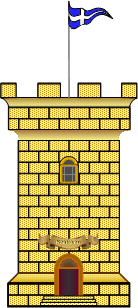Other Info
About Castles |
Definitions and a brief history of castles
Basic Definitions
The word "castle", both in Greek and in English, is of Latin origin.
The Romans called any stronghold, walled place or tower "castrum" (pl.castra) and used the diminutive form, castellum (pl. castella), for everything from a fortress to a dwelling on a hill. Ancient Roman military camps with ditches and palisades, for example, were also called "castra".
"Castellum" is the origin of the English word "castle" and the French "chastel" which became "château". The origin of the German equivalent Burg (and the related burh, borg, berg, burgh) is the Latin Burgus from the Greek Πύργος (=tower)
The Greek word for the castle is κάστρο (kastro), derived directly from the "castrum". It is a generic term describing all kinds of fortifications after antiquity until the 17th century. In the English pages of this site, the word "castle" is used in the same sense. This clarification is necessary because in some sources the definition of castle is limited to "fortified residense".
Definitions from From Meriam-Webster:
Castle-
1- a large fortified building or set of buildings
b : a massive or imposing house
2- a retreat safe against intrusion or invasion
Fortress-
1- a fortified place : stronghold; especially, a large and permanent fortification sometimes including a town.
Tower-
1- a building or structure typically higher than its diameter and high relative to its surroundings that may stand apart (as a campanile) or be attached (as a church belfry) to a larger structure and that may be fully walled in or of skeleton framework (as an observation or transmission tower)
History of Castles
Medieval castles, whether in ruins or restored, dominate the landscapes of many countries in Europe. But these buildings were not an innovation of the Middle Ages.
Early Fortifications
Through out the ages, people built protection around their dwellings: Stone Age people living in caves were building fences to keep out wild beasts; early towns and cities had some sort of wall to keep out invaders; chieftains and local lords lived in fortified houses to protect their families, their power and their wealth.
The advancement of the first great civilizations created the need for increased protection against external threats. This led to the development of defensive structures to a much higher level than the piles of crude rocks and tree trunks of the earlier societies .
From the beginning, the basic element of all fortifications was the tower. The tower has always been a symbol of military architecture, the archetype of all the castles in the world. The oldest known may be the circular stone tower in walls of Neolithic Jericho (8000 BC).
The turreted castle was already fully developed in the ancient Egypt (palace of Abydos). The people of Mesopotamia and the Hittites of Asia Minor also left traces of complex defense structures. Some of the earliest towers were ziggurats, which existed in Sumerian architecture since the 4th millennium BC. Some of these a monuments re still standing today even though they have been built more than 5000 years ago.
An well-known example of an ancient citadel is Troy. Nine different cities had been established in that site. All indicate destruction by earthquake or war. Over and over again the fortress had been rebuilt on the same spot. The 6th citadel was that of Priam and Homer, one of the most celebrated fortresses in world history.
The first European fortifications appeared in Greece. A new era dawned in military architecture with the rise of the Mycenaean civilization there. The citadels of that period were heavily fortified with enormous walls of huge blocks of masonry without mortar. They were built to last for ever and are still impressive today.
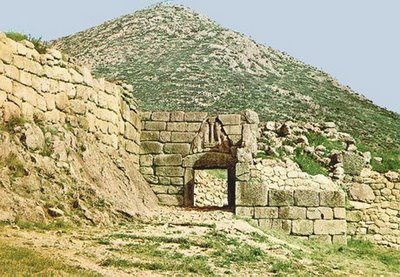 This style of building was attributed by the Greeks of the classical period to mythical giants, the Cyclops, and the walls were named cyclopean. Mycenae and Tiryns in Peloponnese are prime examples of this type of fortification that prevailed from the 14th until 12th century BC and was reproduced in many other cities in Greece. Most of them were destroyed during the Doric immigration but the cyclopean walls became part of later fortifications.
This style of building was attributed by the Greeks of the classical period to mythical giants, the Cyclops, and the walls were named cyclopean. Mycenae and Tiryns in Peloponnese are prime examples of this type of fortification that prevailed from the 14th until 12th century BC and was reproduced in many other cities in Greece. Most of them were destroyed during the Doric immigration but the cyclopean walls became part of later fortifications.
Even Acropolis -another legendary citadel- is partly built on top of cyclopean walls.
Classical Antiquity
In classical Greece, many fortifications were built in the form of citadels, walled cities and military forts. They spread in every corner of the Greek world: the mainland, the Aegean islands, Asia Minor, Sicily, the colonies. The walls were not cyclopean any more but they were more sophisticated. The tower became an important element in the defense both as a watch tower and as a signaling point. It was rectangular and surrounded by outer wall. The city walls were considered a major asset for the strength of the polis, the city-state, a fact that it is evident from many ancient texts, including the discussion about the "Long Walls" of Athens in Thucydides. From a different point of view, castles have always been powerful weapons.
Sparta was the only Greek city without walls. They had been demolished by Lycurgus, the founder of the city’s laws. The Spartans were certain that their brevity and the "human walls" were enough to protect the city.
The Ancient Greeks are not so famous for their fortifications, perhaps because their progress in this area is overshadowed by their achievements in so many other fields. The truth is that castles is another characteristic of the western civilization that was originated in Greece.
The Greek fortifications reached the highest level during the Hellenistic period. Then, the Romans came. The military expansion of Rome brought a new flowering of the art of fortification freeing it from the cultural and princely forms of representation and focusing more on pure military needs. The Romans sited their fortresses mainly in the frontier territories and their building was an affair of the state. They perfected the use of materials and techniques such as rubble and concrete, bricks and mortar, arches and vaults. Masters of efficient organization, they laid out rectangular army camps and cities with major crossing streets and regularly disposed houses or barracks. The Romans, like the Greeks, employed towers and this style was applied to the legions camps and the forts throughout the empire.
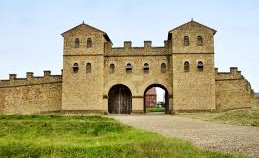
Roman Fort
For the first time during the reign of Antoninus Pius (138-161 Α.D.) a turreted fortress was called burgus. Gradually, towers at important locations grew in size and appearances and fulfilled wider functions than those of a simple fort.
These enlarged burgi began to appear all over the empire starting from outposts in Libya and Syria. Over the time, they grew in size with courtyards, auxiliary buildings, warehouses, gates. The term "tower" was not suitable anymore to describe the whole complex. The term castellum came in use. This is how, in the first centuries A.D., the Roman castle was born and the turreted fortress was established in the western world.
Byzantium
Byzantium was the successor of the Greco-Roman world and inherited its fortification style. The Byzantines built many fortresses and city walls in the Roman way, keeping the construction and ownership of castles under state control.
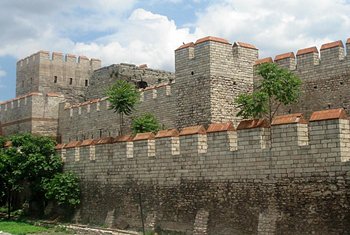 The last great defensive work of the ancient world -and the first of the medieval age- was built in Constantinople which had become the new capital by Constantine the Great in 330 AD. When emperor Theodosius II expanded the city early in the 5th century, he ordered double walls and a moat for the vulnerable side of the city. So effective were these walls that they protected the city for 1000 years until 1453, when the Turks blasted through them using cannons. The walls were built of stone and concrete and bonded with layers of brick, creating a colorful banded effect. The great inner wall had ninety-six towers, each of which could become an independent bastion. The Theodosian walls stood as a model for medieval builders. Such elaborate defenses required the vast resources of an empire to build. No western prince could afford the materials and the resources to replicate the walls of Constantinople. Not until the 12th century did such advanced defensive structures appear in the West.
The last great defensive work of the ancient world -and the first of the medieval age- was built in Constantinople which had become the new capital by Constantine the Great in 330 AD. When emperor Theodosius II expanded the city early in the 5th century, he ordered double walls and a moat for the vulnerable side of the city. So effective were these walls that they protected the city for 1000 years until 1453, when the Turks blasted through them using cannons. The walls were built of stone and concrete and bonded with layers of brick, creating a colorful banded effect. The great inner wall had ninety-six towers, each of which could become an independent bastion. The Theodosian walls stood as a model for medieval builders. Such elaborate defenses required the vast resources of an empire to build. No western prince could afford the materials and the resources to replicate the walls of Constantinople. Not until the 12th century did such advanced defensive structures appear in the West.
The history of Byzantium was evolved around walled cities and fortresses. Many major battles were fought around castles: Dara, Antioch, Aleppo, Amida, Marcellae, Anchialus, Amorium, Dyrrachium, Manzikert. Not to mention the numerous sieges of Constantinople, the walls of which defended repeatedly Europe against invasions from the East.
The Byzantines, like the Romans, paid much attention to the protection of their borders. They had built an extensive network of fortresses along the Taurus mountains in Anatolia along the Danube river, the Rodope mountains in Thrace, later, and elsewhere. Emperor Justinian (527-565) was responsible for the most important work in this field ordering the construction of many forts from Africa to the East.
Byzantium is often underestimated but the fact is that it survived for many centuries despite it was a lonely civilized state surrounded by a sea of barbarian tribes. The Byzantines were able to withstand the continuous attacks and invasions applying innovative military techniques (remember the Greek fire) and building strong fortifications. The decline of the empire started when emperor Constantine IX Monomachus (1042-1055), in an epoch of complacency, neglected the need to maintain the fortresses of the eastern frontier thus leaving it unprotected against the Seljuk Turks.
Castles in Western Europe
After the collapse of the western Roman Empire, Europe experienced a breakdown of law and order and a decline in culture. During a brief period at the end of the 8th and the beginning of the 9th century, the great emperor Charlemagne established a central government, but it did not last long as Charlemagne’s three grand-sons broke up the empire into separate kingdoms.
The "golden Age" of the medieval European castles rose in the 9th century, after the fall of the Carolingian Empire and the division of its territory among local lords and princes. These nobles built castles which were both offensive and defensive structures. Although the military role of the castles is over-emphasized, the structures also served as centers of administration and symbols of power. Urban castles were used to control the local populace and important travel routes, and rural castles were often situated near features that were integral to life in the community, such as mills and fertile land.
During this age, land, not money, was the basis of wealth, power, and authority; and land was at the hands of a very small group of men. As the political and economic system evolved, especially in France and England, the king, who in theory held the land in trust for God, gave his powerful friends parcels of land to exploit in exchange for military support and assistance in administering justice. Vassals would owe service in the local lord’s army and in his court, in exchange for food and lodging at the lord’s castle. But the expense of maintaining an army and running a castle was high. As a result, major land holders complicated the system by subdividing and parceling out their lands to retainers under similar terms. The whole system gave birth to feudalism, a term first used in the 17th century ( from Latin feudum= a grant of land), which became the political and social system of western Europe during the Middle Ages.
In some countries, before a castle could be built it was necessary to obtain the official permission of the king through a license to crenelate or else the owner risked it being seized or destroyed. The castles were powerful war machines and powerful symbols of power and it makes sense why the kings wanted to have control on who was building them.
Near the first millennium, another force would greatly spread the use of castles in Western Europe. The Normans. William the Conqueror, from Normandy, France, invaded England in 1066 and this was a milestone in European history. Medieval societies soon witnessed the erection of stone towers and walls in every country. Simple Norman donjons evolved into more elaborate strongholds with towering walls, defensive systems and could house sometimes thousands of people.
Many castles were originally built from earth and timber, but had their defenses replaced later by stone. Early castles often exploited natural defenses, and lacked features such as towers and arrowslits and relied on a central keep. In the late 12th and early 13th centuries, a scientific approach to castle defense emerged. This led to the proliferation of towers, with an emphasis on flanking fire. Many new castles were polygonal or relied on concentric defense – several stages of defense within each other that could all function at the same time to maximize the castle's firepower. These changes in defense have been attributed to a mixture of castle technology from the Crusades, such as concentric fortification, and inspiration from earlier defenses such as Byzantine forts. Some grand castles had long winding approaches intended to impress and dominate their landscape.
The castle remained a prime military resource for much of the Middle Ages. Military tactics centered on the taking of castles, and weapon technology improved over the centuries to exploit any weakness that could be found in castle architecture.
Although gunpowder was introduced to Europe in the 14th century, it did not significantly affect castle engineering until the 15th century, when artillery became powerful enough to break through stone walls. A turning point in this transitional stage was the siege of Rhodes in 1522. The Ottomans finally captured the island, but the lessons learned in that event changed, literally, the landscape of the European fortifications.
While castles continued to be built well into the 16th century, new techniques to deal with improved cannon fire made them uncomfortable and unattractive for living inside them. As a result, true castles went into decline and were replaced either by artillery forts with no role in civil administration or by country houses with no fortifications. Many fell into ruins during the succeeding centuries, but quite a few were preserved as examples of medieval architecture.
Romantic View
Most people today have a romantic view of castles -complete with knights, fair ladies in distress, jousts, dragons and tournaments.
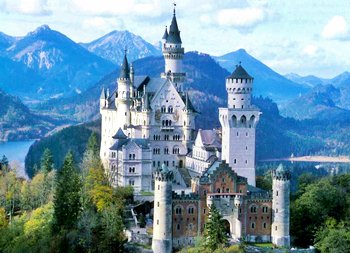
The Neuschwanstein castle
The idea of a castle inspires the image of dreamy magical places with heroic actions, noble romances and stories of "sword and sorcery", far away and long ago. We owe our romantic view of the Middle Ages to the fantasies of authors who wrote about heroic characters like King Arthur and the Knights of the Round Table, Queen Guenevere and Sir Lancelot, and fairy queens and swan maidens.
The classic fairy tales also enhanced this perception as most of them involve an imposing castle with towers, parapets and all.
The interest for castle ruins was born with the age of Romanticism, when the values of the medieval culture were rediscovered and the stories with castles became popular. Romanticism was at its peak between 1800 and 1840 and was basically a reaction to the prevailing Classicism, to the scientific rationalism of nature and, later, to Industrial Revolution. It was also a reaction, especially in Germany, to the events of the French Revolution and it had to do with a feeling of wounded patriotism as a result of the Napoleonic wars.
The movement validated strong emotion as an authentic source of aesthetic experience placing emphasis on such emotions as apprehension, horror and nostalgia. Nostalgia for a more heroic past. The Romantics wanted to reject the classicism which was the cultural norm and to honor their own past, so they glorified Middle Ages with its culture and its architecture. Many were drawn to the scenes of this age, and it therefore comes as no surprise that castles and monasteries attracted their attention.
Among artists, medieval fortresses awakened a longing for what they saw as the ideal past and the desire for the unity of nature and culture. The Romantics were the first to recognize the potential of castles as monuments to a past age, which they then embodied in their work.
This trend which became known as castle romanticism, transformed the castles into symbols of the romantic movement and created a fashion of building mock castles. These buildings were actually luxurious mansions for the upper class without any military purpose. The top example of this trend is the Neuschwanstein Castle in Germany which was built in 1869 by Ludwig II of Bavaria as a retreat and as an homage to Richard Wagner.
Neuschwanstein is a magnificent building and a major tourist attraction, but it is not a real castle. Nevertheless it has become a global castle symbol and it served as a model for the Sleeping Beauty Castle of Disneyland, another universally known "castle"...

Random choice from the top Greek Castles



